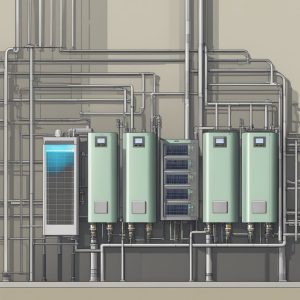Using a Power Station as a UPS: Comparing UPS and Power Station, Differences, and Compatibility with Jackery and EcoFlow Delta 2

If you’re someone who works from home or relies heavily on electronic devices, you may have heard of both portable power stations and uninterruptible power supplies (UPS). Both of these devices serve the purpose of providing backup power in the event of an outage, but there are some key differences between them.
A portable power station is essentially a large battery pack that can be charged via a wall outlet, solar panel, or car charger. It’s designed to be a portable power source that you can take with you on camping trips or use to power small appliances during a power outage. On the other hand, a UPS is a device that’s typically used to protect sensitive electronic equipment, such as computers and servers, from power outages. It’s designed to provide a few minutes of backup power so that you can save your work and safely shut down your devices.
So, can a power station be used as a UPS? The answer is yes, but there are some limitations and caveats to keep in mind. While a portable power station can provide backup power, it may not be able to handle the same load as a UPS. Additionally, a UPS is designed to switch over to battery power seamlessly in the event of an outage, while a power station may require manual intervention to switch over.
In the next section, we’ll explore the differences between UPS backup and power stations in more detail.
Understanding Power Stations and UPS Systems
Defining UPS and Power Stations
Uninterruptible Power Supplies (UPS) and Power Stations are both backup power sources that can provide electricity during power outages. However, they serve slightly different functions and have unique strengths. A UPS provides instant backup energy to sensitive electronics, such as medical devices, critical IT equipment, and other sensitive electronics, while a Power Station is a mobile energy source that can be used for off-grid applications and running equipment.
A UPS is primarily designed to protect sensitive electronic equipment, such as computers and servers, from sudden power outages. When plugged into an electrical outlet, a UPS uses a function called Battery Bypass to feed power directly from the outlet to the device. In other words, the power coming in from the grid bypasses the battery completely to directly power the load device(s). This ensures that critical equipment stays running during a power outage, protecting it from damage and data loss.
On the other hand, a Power Station is a portable battery backup that can be charged from various sources, such as grid power, solar panels, or car chargers. It is designed to provide backup power to devices that require a low to moderate amount of power, such as laptops, smartphones, and small appliances. Power Stations are compact, lightweight, and offer a cost-effective solution to emergency backup power.
Key Differences and Uses
The key difference between a UPS and a Power Station lies in their design and intended usage. While a UPS is designed to protect sensitive equipment from sudden power outages, a Power Station is designed to provide backup power during emergencies or off-grid situations.
A UPS is typically connected to the main power source and provides instant backup energy in case of a power outage. It is ideal for critical equipment that requires uninterrupted power, such as medical devices and IT equipment. A Power Station, on the other hand, is a mobile energy source that can be used for off-grid applications, camping, and outdoor activities. It is ideal for running small appliances, charging devices, and providing backup power during emergencies.
Pros and Cons of UPS and Power Stations
UPS and Power Stations both have their advantages and disadvantages. Here is a table that summarizes the pros and cons of each:
| UPS | Power Station |
|---|---|
| Provides instant backup energy | Can be used for off-grid applications |
| Protects sensitive equipment from power outages | Portable and easy to transport |
| Ideal for critical equipment that requires uninterrupted power | Can be charged from various sources |
| Offers longer runtime than Power Stations | Cost-effective solution to emergency backup power |
| Typically more expensive than Power Stations | Limited storage capacity |
| Requires a dedicated space for installation | Not suitable for running high-power devices |
In conclusion, both UPS and Power Stations serve different purposes and have unique strengths. While a UPS is ideal for protecting critical equipment from power outages, a Power Station is a portable and cost-effective solution for emergency backup power and off-grid applications. When choosing between a UPS and a Power Station, it’s important to consider your power requirements, portability needs, and budget.
Practical Applications and FAQs
Using Portable Power Stations as UPS
Portable power stations can be used as uninterruptible power supplies (UPS) to keep your devices running during power outages subject to the caveats discussed in this article. They provide a reliable backup power source for your electronics, including computers, smartphones, small appliances, and medical equipment like CPAP machines.
One popular option is the EcoFlow Delta 2, which has a battery capacity of 3,126Wh and can power devices up to 2,400W. It also features AC outlets, USB ports, and DC outputs, making it a versatile power source for home, camping, and outdoor activities.
Another option is the Jackery Explorer 1500, which has a battery capacity of 1,500Wh and can power devices up to 1,800W. It is a budget-friendly option for those who need a reliable backup power source for their home or office.
Choosing Between UPS and Power Stations
When choosing between a UPS and a portable power station, consider the primary power source and the features you need. A UPS is designed to protect sensitive electronic equipment like servers and laptops from sudden power outages. It is typically connected to the primary power source and provides a quick transition to backup power.
On the other hand, a portable power station can be used as a primary power source for off-grid living or outdoor activities. It is designed to be portable and versatile, with features like solar panels and USB ports for charging devices.
Common Questions and Expert Answers
Can I use a Jackery as a UPS?
While Jackery stations can technically provide backup power to electronics when an outage occurs, they should not be used as a complete UPS replacement or left continuously connected to equipment. There are a few key reasons:
- Jackery lithium batteries are not optimized to stay perpetually plugged into wall power like lead acid UPS batteries. Frequent full charges decrease Jackery battery lifespan over time.
- Most Jackery models have an automatic shut off after 12 hours if unde a 10 watt load to prevent deep battery discharge when unused. This would disrupt extended backup needs.
- Jackery stations lack surge rating specs sufficient for enterprise UPS demands. Voltage regulation also differs from equipment specifically built for UPS roles.
So in summary – Jackery power stations can effectively power devices during short term outages thanks to integrated batteries and inverters. But for 24/7 UPS roles supporting critical infrastructure demands, true commercial UPS systems better suit both safety and longevity expectations long term.
Jackery works better for periodic backup power uses rather than as the sole, continuously connected protection source for sensitive electronic systems. Properly setting expectations helps ensure users get the most value while understanding operational differences from dedicated enterprise UPS hardware.
Can EcoFlow Delta 2 be used as a UPS?
While EcoFlow stations can provide backup power to electronics when an outage occurs thanks to integrated batteries and inverters, they should not replace true UPS systems for 24/7 protection demands. There are a few key reasons:
- EcoFlow lithium batteries are not designed for continuous wall power pass-through charging like specialized lead acid UPS batteries optimized to remain plugged in.
- Most EcoFlow models have an automatic shut off after a set time if under a low wattage load to prevent deep battery discharge when unused. This would disrupt extended backup needs.
- EcoFlow stations lack the surge rating, voltage regulation, and sustained backup runtimes of enterprise-grade UPS units purpose-built for data centers and other critical systems.
In summary – EcoFlow power stations can effectively power devices during short term grid failures. But for round-the-clock UPS roles supporting infrastructure uptime, commercial UPS hardware is better suited for both safety and longevity.
EcoFlow works better for periodic backup versus as the sole, continuously connected protection source for sensitive electronics. Setting proper expectations helps users maximize value while appreciating EcoFlow differences from heavy duty UPS systems.
What is the difference between UPS backup and power station?
A UPS backup is designed to protect sensitive electronic equipment like servers and laptops from sudden power outages. It is typically connected to the primary power source and provides a quick transition to backup power.
A portable power station, on the other hand, can be used as a primary power source for off-grid living or outdoor activities. It is designed to be portable and versatile, with features like solar panels and USB ports for charging devices.
What scenarios are suitable for using a portable power station as a UPS?
A portable power station can be used as a UPS in various scenarios, including power outages, camping, road trips, construction work, and home offices. It can also be used as a primary power source for off-grid living or outdoor activities.
How do I properly shut down my devices when using a portable power station as a UPS?
When using a portable power station as a UPS, it is important to properly shut down your devices to avoid data loss or damage. Follow the manufacturer’s instructions for shutting down your devices, and be sure to save any unsaved work before shutting down.
